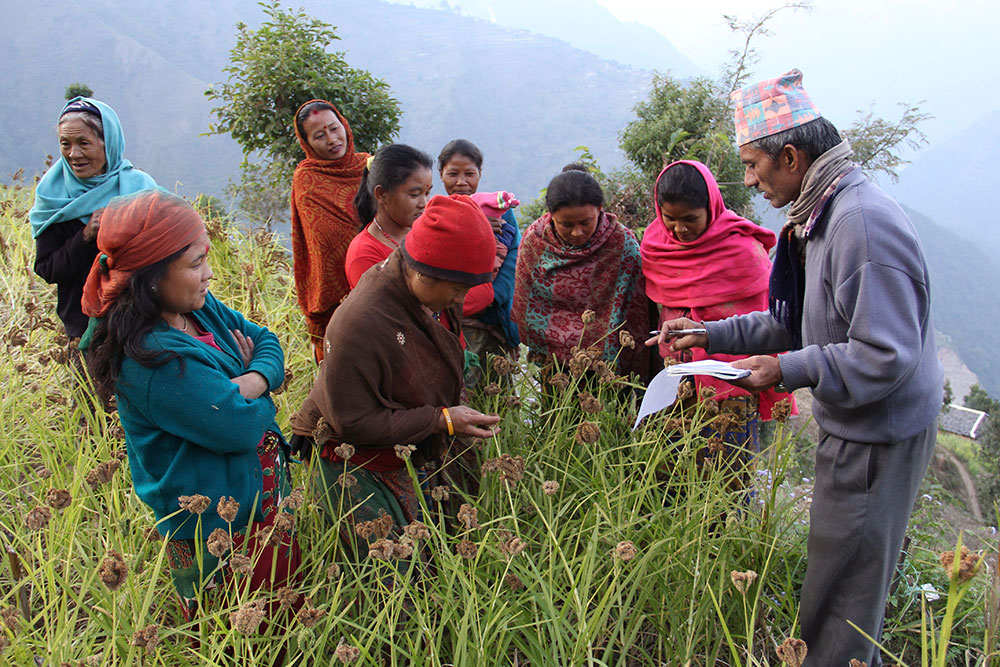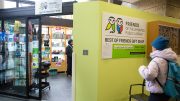Food insecurity, says Laura Husak, is a complex issue that can only be addressed by taking the (sometimes painful) step of crossing disciplinary boundaries. Husak accepted this challenge when she started her master’s studies at the department of anthropology.
Under supervision of Dr. Derek Johnson, Husak is examining how interdisciplinary collaboration for food security initiatives takes place in an international development project funded by the Department of Foreign Affairs, Trade and Development and the International Development Research Centre (IDRC).
The project involves researchers from five Canadian universities, five South Asian NGOs, and two South Asian agricultural universities who are using participatory agricultural research methodologies to test local and new technologies that may improve productivity and improve the status of nutritious small millets, a traditional coarse grain grown in rainfed regions of South Asia.
Finger millet is one of six species collectively labelled small millets that have been cultivated for over 3,000 years in Africa and South Asia. These species have been socially constructed as “poor people’s food” and their contribution to the food and nutritional security in rainfed agriculture is under-recognized by the formal agriculture research sector.
Increasing the productivity, value, and status of small millets is the objective of the ‘Revalorizing Small Millets in South Asia’ (RESMISA) project, funded by the IDRC and the Department of Foreign Affairs, Trade and Development.
If food security is defined as physical and economic access to food, then raising incomes and productivity of the more than 500 million smallholder farmers in the world is key to meeting food production needs for the growing global population and for food security at the household level.
Husak is researching how perceptions of technology for farmers, scientists, and development practitioners differ and how they seek to bring different knowledge together to address a complex problem like food security.
“Lack of appropriate technology is often blamed for the lower productivity of subsistence and smallholder farmers,” says Husak. “I wanted to understand the role of technology in addressing food security, technology being the innovative material, immaterial, and methodological ways we adapt to changing conditions around us.”
Even as the project seeks to address the technical challenges of cultivating small millets and bottlenecks in connecting smallholding farmers to markets, the contribution of anthropology is in connecting the micro and macro perspectives.
“This is done both by taking into account the site-specific impacts of the project and by framing the project within a wider policy context in which food security projects are designed,” says Husak.
“This contribution is essential for defining what is the ‘big picture,’ as quantitative indicators cannot fully explain the diverse reasons people take up or reject particular technologies or the cultivation of particular crops.”
Husak conducts her fieldwork in the foothills of the Annapurna range of the Himalayas in Nepal, where the drastic changes in elevation has created many niche micro-climates and farmers are able to grow a diverse range of crops on terraced hills, including rice, corn, small millets, legumes, and vegetables. Farmers in the area are also rearing animals such as buffalo, goats, and chickens.
There, men and women smallholding farmers play an important role as food producers, not only for their own households but as entrepreneurs as well.
Agriculture is inherently site-specific. In the context of Nepal, “agricultural technologies” are totally different than what we may think of in Canadian agriculture: a variety of seed, a planting or harvesting method, a hand-operated tool or machine.
“While a single variety of canola grows tens of thousands of acres of farmland in Western Canada, in the foothills of the Himalayas one community may cultivate over 50 varieties of rice alone,” says Husak. “Diversity is central to agriculture in Nepal where maize, wheat, small millet, vegetables, and fruits are cultivated.
“In rainfed areas where irrigation cannot be counted on—making up two-thirds of cultivated land in Nepal—a traditional cereal called finger millet (Eleusine coracana) is grown alongside or between maize.”
Husak’s experience in Manitoba local food initiatives provided her an introduction into studying where our food comes from and the values associated with it: “I’m an avid label-reader, but my favourite meals are the ones where I have procured as many ingredients as possible directly from producers, garden or the wild.”
Researching small millets was linked to her interest in the ‘farm to fork’ food systems. Husak wanted to see how a traditional food could be considered a disadvantaged crop by some and at the same time be a highly nutritious and underexploited crop to others. According to Husak, “technology is an entry point between these two, either as a ‘lack’ of appropriate technology or as a potential space for innovation.”
Husak has graduated from the global political economy program at the U of M, which trains students in inter-disciplinary approaches to global challenges. When asked about how exactly she got into this field, Husak does not hesitate.
“My degree in global political economy was fantastic preparation in understanding ‘big picture’ issues like food security. I have been able to bring together my curiosity about why my generation is facing particular challenges with an applied research project. I get to make policy recommendations and be a storyteller.”
The overall message that Husak is helping to spread is: “[that] despite of our efforts to control the variables, there is a level of uncertainty and complexity that often foils our efforts to find consistency and explain linear processes. Farmers, fishers, and others who rely on natural resources for their livelihood may be quick to acknowledge this element of chaos. But something that is potentially difficult to reconcile for policymakers, scientists, or managers of natural resources.”
Debates will continue over the role of technology in agriculture — whether about GMOs, inorganic fertilizer, fossil fuels, water, or climate change. Food security is an issue facing different communities in different ways, and not always bound by national or provincial borders.
When we ask the big question of how to feed the world, it is not just a technical problem of increasing the rate of productivity growth in agriculture – It is linked to specific places and to the people who grow.
As a final thought, Husak emphasizes: “technology is not a panacea, but it can be leveraged! The key message is that we need to look beyond the simple story that ‘technology will solve the sustainability issue.’ Every technology will have unintended impacts (whether positive or negative) and we need to go beyond the tangible and intangible technologies to the social relationships that are behind technology.”
This article was originally published in the Gradzette.



